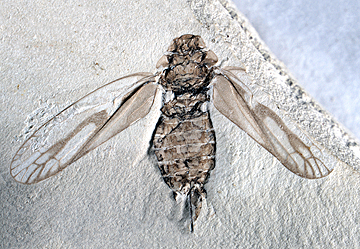Abstract
The amber is a fossilized vegetal resin ranging from a few millions to more than 300 million years (mid-Carboniferous) in age (Sargent Bray & Anderson, 2009). It constitutes a superb material for the conservation of biological inclusions in their minute three-dimensional details (Poinar, 2003).
References
Azar, D., Gèze, R. & Acra, F. (2010) Chapter 14: Lebanese amber. In: Penney. D. (Ed.) Biodiversity of fossils in amber from the major world deposits. Siri Scientific Press, Manchester, pp. 271–298.
Azar, D., Maksoud, S., Nammour, C., Nel, A. & Wang, B. (2018) A new trogiid genus from lower Eocene Fushun amber (Insecta: Psocodea: Trogiomorpha). Geobios, 51, 101–106.
https://doi.org/10.1016/j.geobios.2018.02.002
Cheng, J.H., & Shang, Y.K., (2015) Early Cretaceous palynological assemblage sequence and palaeoclimate research in Zhalainuoer Coalmine, Manzhouli, Inner Mongolia. Acta Geologica Sinica, 54, 3, 316–341.
Han, G., Cao, Y., Zhang, W.J., Wang, J.Y., Xue, Y.F. & Bao, L. (2019) Stratigraphy and sporopollen assemblages of well Bei 32 from the Nantun Formation in the Hailar Basin, Inner Mongolia. Geological Bulletin of China, 38 (6), 916–921. [In Chinese].
Hong, Y.C. (1981) Eocene fossil Diptera insecta in amber of Fushun Coalfield. Geological Publishing House, Beijing. vi+166 pp. [In Chinese].
Hong, Y.C. (2002). Amber insects of China. Beijing Science and Technology Press, Beijing. 653 pp. [in Chinese].
Hong, Y.C., Yang, T.C., Wang, S.T., Wang, S.E., Li, Y.K., Sun, M.R., Sun, H.C., & Tu, N.C. (1974). Stratigraphy and Palaeontology of Fushun coal-field, Liaoning Province. Acta Geologica Sinica, 2, 113–149.
Inner Mongolia Autonomous Regional Bureau of Geology and Mineral Resources. (1996) Lithologic stratigraphy of Inner Mongolia Autonomous Region. China University of Geosciences Press, Beijing. 344 pp. [In Chinese].
Poinar, G.O. Jr (2003) Amber. In: Resh, V.H. & Cardé, R.T. (Eds.), Encyclopedia of insects, Academic Press, [Amsterdam], pp. 9–12.
Pu, R.G. & Wu, H.Z. (1985) The palynological assemblages of the Xinganling and Zhalainuoer in Xinganling region, northeastern China and their stratigraphical significance. Bulletin of the Shenyang Institute of Geology and Mineral Resources, Chinese Academy of Geological Sciences, 11, 47–113. [In Chinese with English Summary].
Sargent Bray, P. & Anderson. K.B. (2009) Identification of Carboniferous (320 Million Years Old) Classic Amber. Science, 326,132–134.
https://doi.org/10.1126/science.1177539
Shi, G.L., Dutta, S., Paul, S., Wang, B. & Jacques, F.M.B. (2014) Terpenoid compositions and botanical origins of Late Cretaceous and Miocene amber from China. PLoS ONE, 9 (10), e111303.
https://doi.org/10.1371/journal.pone.0111303
Wang, B., Rust, J., Engel, M.S., Szwedo, J., Dutta, S, Nel, A., Fan, Y., Meng, F.W., Shi, G.L., Jarzembowski, E., Wappler, T., Stebner, F, Fang, Y., Mao, L.M., Zheng, D.R. & Zhang, H.C. (2014) A Diverse paleobiota in Early Eocene Fushun amber from China. Current Biology, 24, 1606–1610.
https://doi.org/10.1016/j.cub.2014.05.048
Wang, H, Dutta, S., Kelly, R.S., Rudra, A., Li, S., Zhang, Q.Q., Zhang, Q.Q., Wu, Y.X., Cao, M.Z., Wang B., Li, J.G. & Zhang, H.C. (2018) Amber fossils reveal the Early Cenozoic dipterocarp rainforest in central Tibet. Palaeoworld, 27 (4), 506–513.
https://doi.org/10.1016/j.palwor.2018.09.006
Wang, Y.Q., Sha, J.G., Pan, Y.H., Zhang, X.L. & Rao, X. 2012. Non-marine Cretaceous ostracod assemblages in China: a preliminary review. Journal of Stratigraphy 36, 289–299.
Wu, H.Y., Huang, Q.H., Dang, Y.M., Kong, H. & Wang, L.Q. (2006) Achievements in the study on Cretaceous biostratigraphy of the Hailaer Basin, Inner Mongolia. Acta Palaeontologica Sinica, 45 (2), 283–291. [In Chinese with English Summary].
Zhang, C., Wu, X.W., Zhang, Y.J., Guo, W., Qin, T. & Quan, J.Y. (2017) Chronology of Early Cretaceous volcanic rocks from the Longjiang Basin and its tectonic implications. Geological Review, 63 (supplement), 295–296. [In Chinese].

